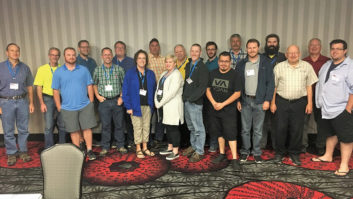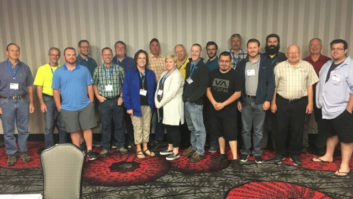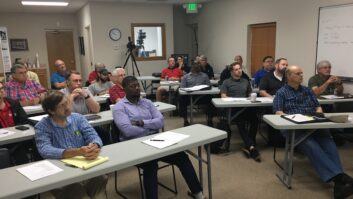If you haven’t visited your state broadcast association’s website lately, try it. Many association websites offer a wealth of information.
The Alabama Broadcasters Association, home of the ABA Engineering Academy, is a case in point. Its fall Radio and Television Engineering Classes have been updated.
The radio class has added more information about audio over IP, digital audio, HD Radio and AM/FM antenna operations. The television class explores video over IP (SMPTE 2110), ATSC 3.0 and the television repack. Both classes also include maintenance guidelines for current technology.
The Radio Class is scheduled for the week of Sept. 24–28, and the Television Class is the week of Oct. 15–19. You can register online at http://al-ba.com/wp2/aba-engineering-academy.
***
In our recent site inspection discussion we spoke about posting informative license information.
Although the FCC posting requirement is being reviewed, the ABA newsletter reminds engineers of the FCC rules requiring a station log. The log must contain entries covering EAS activities, any tower light malfunction and compliance with the terms of the station license. It must be reviewed weekly, signed and dated by the station chief operator.
To aid stations in maintaining this log, the ABA has put together a sample station log for documenting the required information for the entire month. ABA reminds engineers that these logs are required to be retained for two years.
You can download a copy of the sample station log at http://al-ba.com. Click on the EAS tab at the top of the page.
***
Speaking of EAS, the ABA website also reported that Sage Alerting Systems had released a firmware update that you must install to allow your ENDEC to continue to receive EAS CAP alerts from FEMA. Radio World reported this too in our Newsbytes e-newsletter.
A FEMA signing certificate expires at 11:45 a.m. June 24. If you do not install this update, you will not receive CAP messages from the IPAWS system after June 24.
You can find the release notes at www.sagealertingsystems.com/release1-1/cr-rev4-release-notes.pdf. The firmware update is straightforward, and the update will not change any of the settings on your ENDEC.
The installation process is straightforward and is described in the release notes. Installing this update will not change any of the settings on your ENDEC. If you have questions, call Sage Alerting Systems at (914) 872-4069 and press 1 for support.
***
Marc Mann of San Diego offers readers a suggestion, after reading the May 23 Workbench column in which I highlighted the “insurance” of having an inexpensive LED flashlight ready to go.
It’s been Marc’s experience that most inexpensive and expensive LED flashlights rely on a three-position pushbutton switch, mounted in the tailpiece, for actuation. The issue is that these three-position switches (Off-On-Strobe) don’t provide a true battery disconnect “off” function. The circuit relies on this simple latching switch feature to toggle amongst the choice of light desired. So what we end up with is a constant parasitic drain on the batteries.
This drain can cause the batteries not only to fail but to leak when needed most. Merely having spare batteries won’t help, as the corrosion from leaked battery electrolyte insulates the battery terminals.
A well-known brand of flashlight that uses an aluminum case (as many now do) is tough — except when the batteries leak. When that occurs, the electrolyte creeps into the tailpiece screw threads. This prevents you from ever opening the flashlight again! (Marc adds that he knows; he’s tried.) Yes, you can try lubing the threads initially with Vaseline or anti-seize compound but this can cause a mess.
So the next question is whether there really is any new kind of flashlight available. Surprisingly, yes. Instead of multi-groups of individual LEDs, there is now COB, short for “chip on board.”
Marc suggests you look at the NEBO brand of “Big LarryC” pocket-size Cob flashlights. These flashlights are compact, built well and affordable, with base models as low as $9.99. These flashlights are also available at Ace Hardware and through online shopping. Head to www.acehardware.com and in the search block enter “NEBO LarryC.” Or on Amazon, search “6306-Flashlight-Worklight-Magnetic-Assorted” for a variety of models and price points.
Whichever you decide, Marc’s advice is to look for flashlights with positive on-off switches. By the way, does anyone really use that strobe function?
***

Let’s wrap up with a little point about the GFI outlets, featured in Fig. 1. Some plugs cover the test/reset pushbuttons on these outlets, shown in Fig. 2.

If the plugs are not periodically removed, you may forget that it’s a GFI at all. This can have you running in circles, wondering why there’s no power.
A solution? Get your labeler out and print a label to be mounted above the outlet, identifying it as a GFI.
Contribute to Workbench. You’ll help fellow engineers and qualify for SBE recertification credit. Send Workbench tips and high-resolution photos to [email protected]. Fax to (603) 472-4944.
Author John Bisset has spent 48 years in the broadcasting industry and is still learning. He handles western U.S. radio sales for the Telos Alliance. He is SBE certified and is a past recipient of the SBE’s Educator of the Year Award.











